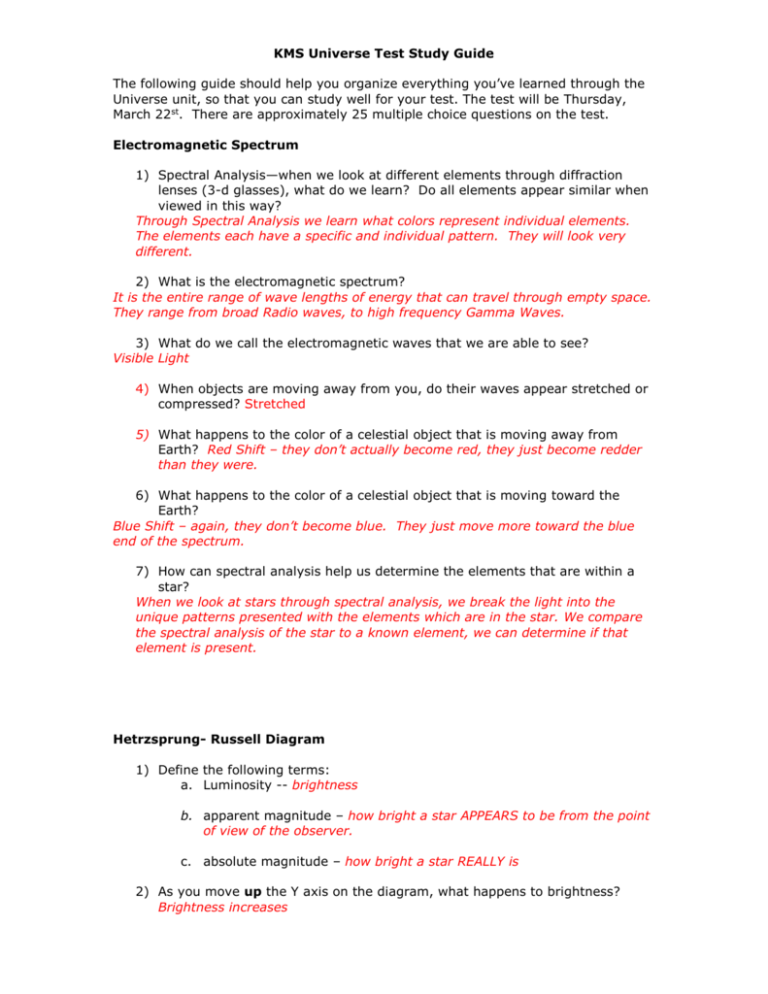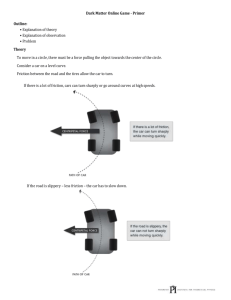KMS Universe Test Study Guide
advertisement

KMS Universe Test Study Guide The following guide should help you organize everything you’ve learned through the Universe unit, so that you can study well for your test. The test will be Thursday, March 22st. There are approximately 25 multiple choice questions on the test. Electromagnetic Spectrum 1) Spectral Analysis—when we look at different elements through diffraction lenses (3-d glasses), what do we learn? Do all elements appear similar when viewed in this way? Through Spectral Analysis we learn what colors represent individual elements. The elements each have a specific and individual pattern. They will look very different. 2) What is the electromagnetic spectrum? It is the entire range of wave lengths of energy that can travel through empty space. They range from broad Radio waves, to high frequency Gamma Waves. 3) What do we call the electromagnetic waves that we are able to see? Visible Light 4) When objects are moving away from you, do their waves appear stretched or compressed? Stretched 5) What happens to the color of a celestial object that is moving away from Earth? Red Shift – they don’t actually become red, they just become redder than they were. 6) What happens to the color of a celestial object that is moving toward the Earth? Blue Shift – again, they don’t become blue. They just move more toward the blue end of the spectrum. 7) How can spectral analysis help us determine the elements that are within a star? When we look at stars through spectral analysis, we break the light into the unique patterns presented with the elements which are in the star. We compare the spectral analysis of the star to a known element, we can determine if that element is present. Hetrzsprung- Russell Diagram 1) Define the following terms: a. Luminosity -- brightness b. apparent magnitude – how bright a star APPEARS to be from the point of view of the observer. c. absolute magnitude – how bright a star REALLY is 2) As you move up the Y axis on the diagram, what happens to brightness? Brightness increases 3) As you move across the X axis of the diagram, what happens to surface temperature? Surface temperature decreases 4) Where is the sun found within the H-R diagram? In the Main Sequence 5) Sketch an H-R diagram and label the main sequence, white dwarf, and giant/super giant regions on the diagram. 6) Why does the sun have such a great apparent magnitude, when it has only an average absolute magnitude? The Sun is very close to us, so it appears to be brighter than it is compared to other stars in the Universe. 7) Why are red giant stars so bright, when they are among the coolest of stars? Because they are very large. 8) Why do white dwarf stars appear so dim, when they are so hot? Because they are very small Life Cycles of Stars 1) What is the most abundant element in the universe? Hydrogen 2) What is a nebula? A cloud of gas and dust, from which stars are formed. 3) What force within a nebula helps the matter within the nebula coalesce? Gravity 4) Matter in nebulae forms into great spheres and starts to heat up and glow from heat and pressure. What is said to have been formed at this point? A Protostar 5) What process leads to a star entering the “main sequence” of its cycle? Hydrogen fusion 6) Draw a flow chart for the life cycle of an average sized star in the space below. At each phase, describe what has happened in the star’s “life” to cause it to enter or leave that stage. 7) Draw a flow chart for the life cycle of a very large star in the space below. each phase, describe what has happened in the star’s “life” to cause it to enter or leave that stage. At 8) What determines whether a star ultimately becomes a black hole or a neutron star? The mass of a star determines what happens at the end of it’s life cycle. Very large stars become neutron stars, or Black Holes. 9) What determines whether a star will ultimately explode as a supernova? It’s Mass. Larger Mass stars may explode as Super Nova. Galaxies 1) Sketch and label the three types of galaxies in the space below. Spiral Elliptical Irregular 2) What is the name of the galaxy we live in? What type of galaxy is it? Where is our solar system found within this galaxy? Milky Way It is a Spiral Galaxy. Our solar system is found near the end of one arm of the spiral. 3) Because galaxies and the universe that contains them are so enormous, what unit of measurement is used to describe great distances between stars and galaxies? Light year—the distance that light travels in one year. 4) Theoretically, what event caused the expansion of the universe, and created all the matter which has organized into planets, stars, and galaxies over time? The Big Bang











